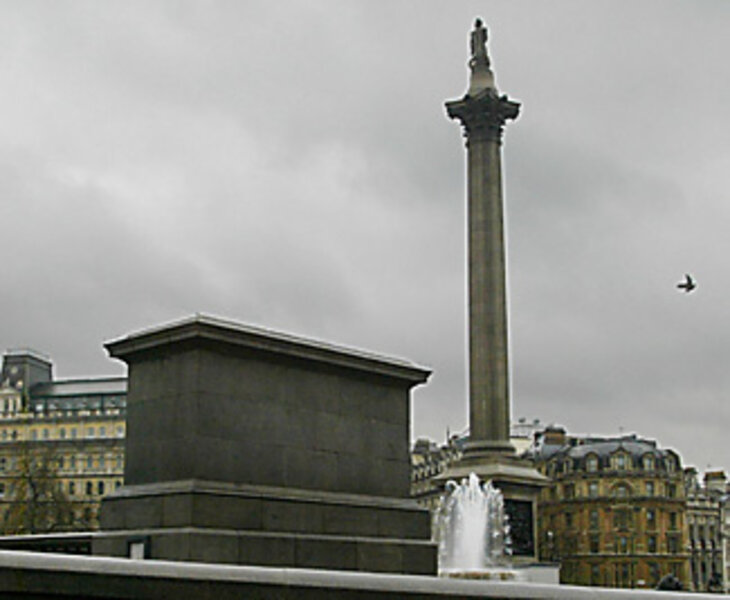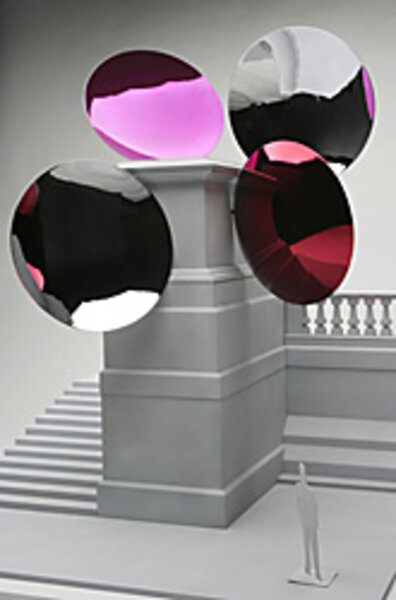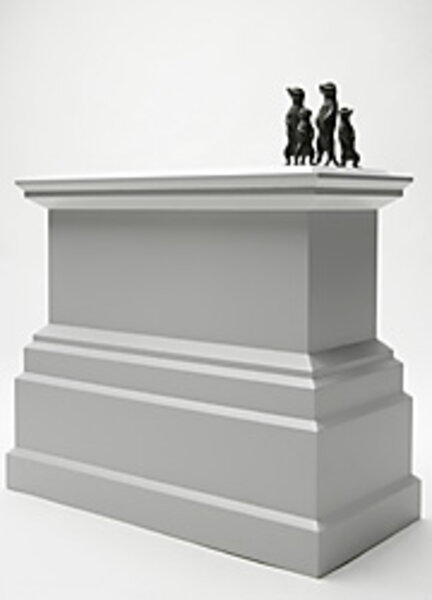London wants to put Britishness on a pedestal
Loading...
| London
The National Gallery in central London isn't normally where individuals gather to exercise their "people power." It's far too demure and Victorian. The only sounds usually heard in this cathedral of art are the click-clacking of visitors' high-heels and the pencil-scribbling of students doing their own versions of Van Gogh's Sunflowers.
But one morning last week, as a dewy fog spread from Trafalgar Square and dampened the gallery's windows, Stacy Marks, a 17-year-old student with an eyebrow piercing and a neon-pink bag slung over her shoulder, was here to "stir things up."
"I want to change central London – and possibly the country," she told me. She wasn't planning a sit-in, or a megaphone-enabled protest against a particularly unpopular painting – she was casting her vote in the consultation process to find a new monument for the fourth plinth, the historically empty plinth in Trafalgar Square.
Three of the plinths in Britain's best-known public square carry statues of heroic military men. And, of course, Adm. Horatio Nelson – the hero of the 1805 Battle of Trafalgar between England, France, and Spain – stands atop a column in the middle of the square. But the mysterious fourth plinth in the northwest corner has stood empty for more than 150 years. Now, the National Gallery is showing scale models of six proposed monuments that might occupy the lonely plinth. And it's inviting the public to chip in to the debate.
"It must be that one, definitely," said the eager Ms. Marks, pointing to "Faîtes L'Art, pas La Guerre" ("Make Art, Not War"), a huge wind-powered antiwar installation by Bob and Roberta Smith. Its bright flashing lights and immense colorful lettering is more Woodstock 1969 than it is central London militaristic square 2008.
"That's the point!" she says, scribbling her reasons for her pick on a feedback card and dropping it in the gallery box. "It will send a message to the people who run Britain and the people who live in it: no more war."
The very Frenchness of the monument challenges the notion of British military supremacy that is the foundation of Trafalgar Square. Indeed, the info-card next to "Make Art, Not War" describes it as a "gentle provocation to the overwhelming Hogarthian stature of Trafalgar Square as the centre of celebration of Britain's military achievements over the French."
Marks seems a little thrown by the arty lingo, but nods anyway. "Exactly. Challenging Hogarthianism. Exactly," she says.
• • •
The World War I poet Rupert Brooke once said of British war graves in foreign countries: "There's some corner of a foreign field that is for ever England."
Well, in Trafalgar Square there's a corner that is forever blank, forever confused – a gaping hole where England, or at least Englishness, ought to stand tall and proud, but doesn't.
The empty fourth plinth has come to symbolize a British crisis of values and heroism.
Trafalgar Square was completed in 1845. Statues – of King George IV, and India-based British military men Sir Charles James Napier and Henry Havelock – were mounted on three plinths. The fourth was supposed to carry a statue of King William IV. But successive governments failed to fund it. As decades rolled by, there were heated debates about whether a new, different statue should be erected on the plinth. Who should it commemorate? Another military man? An inspiring politician? A royal?
Governments could never agree, and the statueless fourth plinth, standing out like an architectural sore thumb in a square stacked with statues, lions, and pillars, became an unwitting ad for the indecision about who best represents national British values, and what Britain is about.
In 1999, the Royal Society of Arts and the Greater London Authority set up the Fourth Plinth Project, commissioning a series of temporary sculptures to occupy the plinth. Most of them have been playful, or knowingly provocative.
In 2001, British sculptor, Rachel Whiteread, made an exact resin-based replica of the fourth plinth ... and placed it on top of the plinth. Everyone agreed that it was très witty and postmodern, but it also captured the identity crisis at the heart of the problem: in idolizing the plinth itself, Whiteread elevated its very emptiness, the very indecision that meant the stone block has stood uninhabited for 150 years, to the level of a public monument.
"The fact that the fourth plinth keeps changing contradicts the traditional idea of a 'monument,' which is supposed to have longevity," says Munira Mirza, author of "Culture Vultures: Is UK Arts Policy Damaging the Arts?"
Ms. Mirza believes that the turnover of temporary statues since 1999, and the consultation to find a new one now, "suggests that our society is uncomfortable with the idea of a permanent value that can last into the future. There is plenty of 'values discourse' around today, but these values seem transitory and only surface-deep."
• • •
Outside the National Gallery, a handful of tourists wandered around the square, disappointed that the once-famous home to 35,000 rock pigeons seemed almost bird-free. But in an attempt to relieve the square of the tyranny of pigeon poo, London Mayor Ken Livingstone has banned the feeding of pigeons and even employed falcons to chase them away.
"I wanted a photo with the pigeons!" says Aidan Kelly from South Africa. Instead he got "Hotel for the Birds," the monument that will occupy the fourth plinth until the Fourth Plinth Commissioning Group has decided which of six new proposed monuments to select. Made by the German-born artist Thomas Schutte, the "Hotel" is a colorful, plastic-and-metal minibuilding for pigeons – if there were any left. "I like it," says Mr. Kelly. "It's easier on the eye and the senses than the other gray statues around here."
The six proposed plinth monuments on show in the National Gallery are also strikingly different from Trafalgar's "gray statues." One proposal is a statue of a family of meerkats. Another is an enormous, sky-reflecting conclave of mirrors that the artist wants to look as if the sky itself has been "brought down to the ground." Perhaps the most ambitious proposal is sculptor Anthony Gormley's "One and Other," which would place safety nets around the plinth and have living, breathing members of the public atop it. Each person would stand on the plinth for an hour – 8,760 living monuments (kings and generals in their own right) over one year.
Two of the proposals are antiwar: the French-leaning wind-powered installation, and "The Spoils of War" by Jeremy Deller, which is not an artwork but the remains of a car that was attacked in the war in Iraq.
For Mirza, the antiwar monuments, both reactions to the Iraq war, sum up the "vacuum of values" embodied in the fourth plinth. "The antiwar ideas misunderstand the point of a monument space. It's not supposed to be a one-off political point about current events – it is supposed to embody something more transcendent, a value we believe in for a long period of time." The absence of this "transcendent idea of Britishness" makes the plinth a confused space, she says.
Ekow Eshun has a different take. He's the artistic director of the Institute of Contemporary Arts on The Mall, the long, wide road that runs from Trafalgar Square to Buckingham Palace, and a member of the Fourth Plinth Commissioning Group. But he can't tell me which of the six new proposals he prefers, he says, because "firstly I'm not allowed to, and secondly I haven't decided yet."
For Mr. Eshun, it's precisely the changing nature of the plinth that is exciting. "In the rest of the square, you have these strange dead colonels, these warlike monuments, and Britain is ready for something different," he says. "It is the role of artists to grapple with discord and to tackle the problems of the nation, and artists are now doing that very publicly on the plinth."
But the continual replacement of one abstract, sometimes obscure, monument with another points to a problem, says Mirza: "Britain has lots of celebrities who are well known and admired today, but we don't seem to have any heroes. A hero usually rises above the ordinary because he or she exemplifies some virtue that everyone can recognize. Who is that today? The fortunes of the fourth plinth suggest there isn't one."
• • •
On a bench beneath the fourth plinth last week, Una Dowling, a graphic designer, ate her lunch, contemplating the tourists contemplating the "Hotel for the Birds."
"I think it should be empty again," she says. "It was more interesting then, almost poetic."









